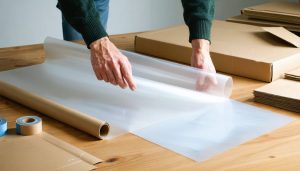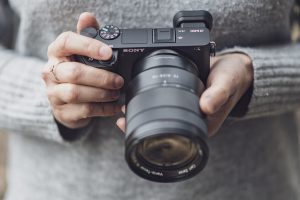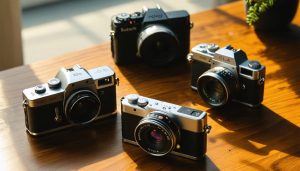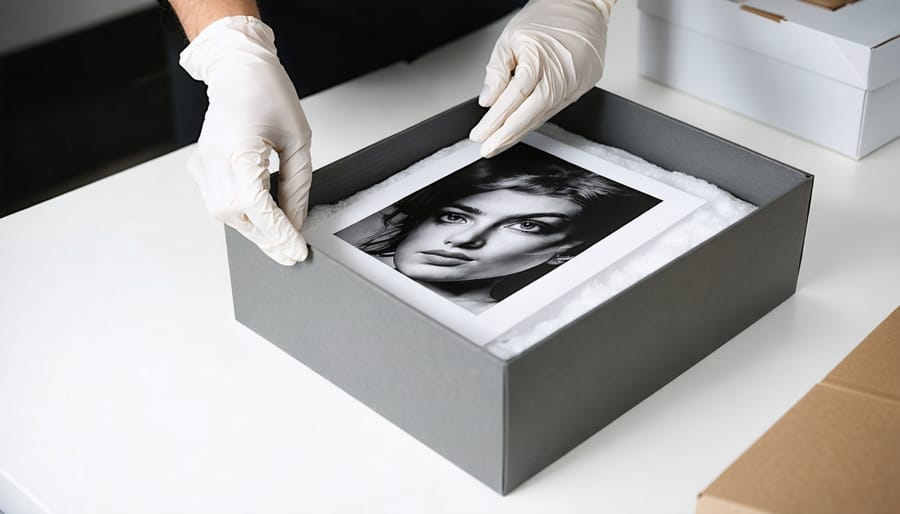
Your photographs deserve the same protection museums give their most valuable collections, and University Products archival boxes deliver exactly that level of preservation. These aren’t ordinary storage containers—they’re precision-engineered solutions designed by archivists to protect prints, negatives, and documents for decades, even centuries, using acid-free, lignin-free materials that prevent the chemical degradation that destroys irreplaceable images.
University Products has built its reputation over 50 years by serving professional archives, museums, and libraries, which means their boxes meet rigorous preservation standards most consumer products ignore. The difference shows in the details: their materials undergo independent testing for PAT (Photographic Activity Test) compliance, ensuring nothing in the box will react with your photographs over time. When you’re storing limited edition prints you’ve spent hours perfecting in the darkroom or irreplaceable film negatives from a once-in-a-lifetime shoot, these specifications matter tremendously.
Understanding which University Products box fits your specific needs—whether you’re organizing 35mm negatives, storing large-format prints, or protecting a mixed collection—requires knowledge of archival principles and practical workflow considerations. The initial investment costs more than generic storage, but professional photographers and serious collectors consistently choose these boxes because degraded photographs can’t be recovered. This guide breaks down the technical aspects of archival storage, explains what makes University Products boxes different from standard options, and provides straightforward recommendations for selecting the right products for your collection’s long-term preservation.
What Makes University Products Archival Boxes Different
University Products has been a trusted name in archival preservation since 1968, earning their reputation by doing one thing exceptionally well: creating storage solutions that actually protect your materials for the long haul. Unlike companies that dabble in archival products as a side offering, University Products focuses exclusively on conservation-grade materials, working closely with museums, libraries, and professional archivists to develop products that meet rigorous preservation standards.
So what makes their archival boxes genuinely different from those seemingly similar containers at your local craft store? The answer lies in what these boxes are made of, and more importantly, what they’re not made of.
Regular cardboard boxes contain acids and lignin, a natural compound found in wood pulp that breaks down over time. As lignin deteriorates, it releases acids that can yellow, weaken, and ultimately destroy photographs. Think of those old newspaper clippings that turn brittle and brown after just a few years. That’s lignin degradation in action, and it’s exactly what you want to avoid when storing your precious prints.
University Products boxes are manufactured from acid-free, lignin-free board. This means the materials won’t generate harmful chemicals as they age. The acid-free designation indicates a pH level of 7.0 or higher, creating a neutral or slightly alkaline environment that won’t attack your photographs over decades of storage.
But here’s where University Products goes a step further. Many of their boxes carry PAT certification, which stands for Photographic Activity Test. This rigorous examination, outlined in ISO standard 18916, specifically tests whether materials will damage photographs through chemical interaction. Products undergo accelerated aging tests at elevated temperatures and humidity levels to simulate years of storage conditions. Only materials that pass without causing any discoloration, fading, or staining to photographic emulsions earn PAT approval.
Why does this matter for your photography collection? Consider that many family photos and fine art prints represent irreplaceable moments or significant investments. A wedding photographer’s portfolio, a collector’s vintage prints, or your grandmother’s photographs deserve protection that extends beyond your lifetime. PAT-certified boxes provide documented assurance that your storage solution won’t become the very thing that destroys what you’re trying to preserve.
This commitment to tested, proven materials distinguishes University Products from generic storage options, making them the go-to choice when preservation really matters.


The Science Behind Archival Preservation
Understanding pH Levels and Acid-Free Materials
When you’re investing in archival storage, you’ll frequently encounter terms like “acid-free” and “pH neutral,” but what do they actually mean for your photographs? Think of it this way: acid is like slow-motion poison for your prints. Over time, acidic materials release compounds that cause yellowing, brittleness, and eventually complete deterioration of your precious images.
Acid-free materials have been specially treated or manufactured to remove lignin and other acidic components. pH neutral means the material measures around 7 on the pH scale, neither acidic nor alkaline. University Products archival boxes typically maintain a pH between 7.5 and 8.5, which creates a slightly alkaline buffer that actually protects against environmental acids.
Here’s where it gets interesting for photographers: different types of prints have varying sensitivities to pH levels. Silver gelatin prints, those classic darkroom beauties, are particularly vulnerable to acid damage. Even trace amounts can cause oxidation spots and image fading within years rather than decades. Inkjet prints using pigment-based inks are more forgiving but still benefit significantly from acid-free storage. Dye-sublimation prints, while generally stable, can experience color shifts when exposed to acidic environments.
The practical takeaway? Using truly archival boxes isn’t just marketing hype. A photographer I know once stored family portraits in regular cardboard boxes. After twenty years, brown stains had migrated from the box directly onto the print edges. Acid-free storage prevents these heartbreaking outcomes, ensuring your work survives for generations.
Buffered vs. Unbuffered: Which Box Do You Need?
Here’s something many photographers get wrong when storing prints and negatives: choosing between buffered and unbuffered archival boxes. The difference matters more than you might think, and using the wrong type can actually damage your precious images over time.
Buffered archival materials contain calcium carbonate or magnesium carbonate, which neutralizes acids that develop naturally as paper ages. Think of it as a protective shield that absorbs harmful acids before they can attack your photographs. Most paper-based materials, including modern prints, documents, and matte fiber-based prints, benefit from this extra protection. If you’re storing black and white prints, contact sheets, or printed documents, buffered boxes are typically your best choice.
Unbuffered materials, on the other hand, contain no alkaline additives. This neutral pH environment is essential for certain photographic materials. Color photographs, albumen prints, chromogenic prints, and any protein-based materials actually deteriorate faster when exposed to alkaline buffers. The chemicals in color photos can react negatively with the buffering agents, leading to fading or discoloration.
The most common mistake? Photographers assume all archival boxes are created equal and grab whatever’s labeled “acid-free” without checking the buffering status. Another frequent error is storing mixed media together. If you’re archiving both color slides and black and white prints, they need separate storage solutions.
When in doubt, unbuffered is the safer universal choice since it won’t harm either material type, though buffered offers superior long-term protection for compatible materials. University Products clearly labels their boxes, making the selection process straightforward once you understand what your collection needs.
Types of University Products Archival Boxes for Photographers
Print Storage Boxes and Drop-Front Cases
For photographers who’ve invested time and resources into creating beautiful print quality work, University Products offers specialized flat storage boxes and drop-front cases designed specifically for print preservation. These boxes differ from standard archival boxes by providing horizontal storage that prevents prints from bending or curling over time.
The most popular option is their drop-front design, which allows you to access your prints without lifting them out vertically. This matters more than you might think. When you store prints in traditional boxes, you risk surface abrasion every time you remove or replace them. The drop-front design lets the front panel fold down completely, giving you flat access to your collection.
University Products offers these boxes in standard print sizes ranging from 11×14 inches up to 20×24 inches, with depths varying from 1.5 to 3 inches depending on your storage needs. The construction uses the same acid-free, lignin-free materials as their document boxes, with reinforced corners that maintain their shape even when fully loaded.
Here’s a practical tip from professional archivists: always interleave your prints with acid-free tissue paper or glassine sheets. This creates a protective barrier between prints and prevents potential ink transfer or surface sticking, especially in humid conditions. Store prints with the image side facing up, and never overfill your boxes. If you’re forcing the lid closed, you have too many prints inside, which can cause pressure damage to the bottom layers.

Negative and Slide Storage Solutions
If you’re sitting on a collection of negatives or slides—whether that’s your grandfather’s Kodachrome memories or your own film work from recent shoots—you’ll need specialized storage that goes beyond standard archival boxes. University Products offers a thoughtful range of solutions specifically designed for film storage, combining protective materials with smart organizational features.
The foundation of proper negative storage starts with archival-quality sleeves made from polypropylene or polyester. These materials are chemically stable and won’t react with your film emulsion over time, unlike PVC sleeves that can release harmful plasticizers. University Products’ negative preservers are designed to fit seamlessly into their box systems, typically accommodating standard 35mm strips or medium format negatives. The key advantage here is the modular approach—you can store sleeved negatives in drop-front boxes or flip-top designs, keeping everything protected from dust, light, and handling damage while maintaining easy access for scanning or printing projects.
For slide collections, dedicated slide storage boxes offer superior organization. These typically feature individual compartments or use archival slide pages that prevent the mounts from rubbing against each other, which can cause scratching over time. A practical tip from professional archivists: always store slides vertically rather than stacking them flat, as this reduces pressure on the film surface.
The real-world benefit of this integrated system becomes apparent when you’re managing mixed media archives. You might have negatives from a 2019 road trip alongside slides from a 1970s family vacation—both can live in compatible storage solutions that stack neatly on your shelf. This consistency makes inventory management simpler and ensures every piece of film receives the same level of protection, regardless of format.
Portfolio and Oversized Print Boxes
When you’re dealing with large format prints, panoramic shots, or portfolio presentations, standard boxes simply won’t cut it. University Products offers specialized oversized and portfolio boxes designed specifically for these challenges, giving photographers a professional storage solution that matches the quality of their work.
Their portfolio boxes come in various depths and dimensions, accommodating everything from 16×20 inch prints up to 30×40 inches and beyond. These aren’t just bigger versions of regular boxes—they’re engineered with reinforced corners and rigid construction to prevent sagging or warping over time. The drop-front design makes accessing your prints remarkably easy without having to remove the entire lid, which becomes increasingly important when you’re working with larger, heavier pieces.
For photographers preparing work for exhibitions or client presentations, these boxes serve double duty. They’re perfect for transporting prints safely to galleries or meetings while providing long-term archival storage between shows. The professional appearance alone makes a strong impression when you arrive at a venue with properly stored work.
Think about your largest prints and add at least two inches to each dimension when selecting a box size. This extra space allows for protecting your prints with tissue interleaving without cramming them in, which defeats the purpose of archival storage entirely.
Clamshell Boxes for Special Projects
Clamshell boxes represent the premium tier of archival storage, and they’re worth the investment when your work demands maximum protection. Think of these as the vault-level option for your most valuable prints. Unlike drop-front boxes, clamshells fully encase your materials, providing superior protection against light, dust, and handling damage on all sides.
You’ll want to consider clamshells for fine art prints destined for gallery walls or collector portfolios, limited edition series that represent significant time and financial investment, and special projects like client wedding albums or commissioned work. They’re also ideal when shipping prints to clients or exhibitions, as the rigid construction and secure closure provide peace of mind during transit.
The higher price point typically reflects museum-quality construction with reinforced corners and precise tolerances. While a standard drop-front box might cost five to ten dollars, clamshells can run twenty dollars or more depending on size. For professional photographers building their portfolio or archiving commissioned work, this investment protects both the physical print and your professional reputation.
Real-World Usage: Setting Up Your Archival System
Organizing Your Collection for Long-Term Access
Just like organizing your collection digitally requires structure, physical archival storage demands a thoughtful system that balances preservation with practical access. I learned this the hard way after spending three hours searching through unmarked boxes for a specific negative collection—a mistake I never repeated.
Start with clear, acid-free labels on both the box front and side. Include basic information: contents, date range, and a unique identifier. For example, “Portrait Sessions 2018-2020, Box P-001” gives you instant context without opening anything. University Products offers compatible labeling systems that won’t damage your archival materials.
Create a master inventory spreadsheet or database that maps your numbering system to detailed contents. List what’s inside each box, including specific projects, formats, and any special handling notes. This becomes invaluable when clients request reprints or you need reference materials years later.
When arranging boxes on shelves, place frequently accessed collections at eye level and keep similar formats together. Your working files might occupy premium real estate, while decade-old tax documents can sit higher up. Remember that archival boxes stack beautifully, but limit height to prevent crushing and maintain easy access.
Consider creating a simple floor plan showing box locations by number range. One photographer friend uses color-coded tape on shelf edges corresponding to different decades—a visual system that makes retrieval intuitive even for assistants unfamiliar with the collection.
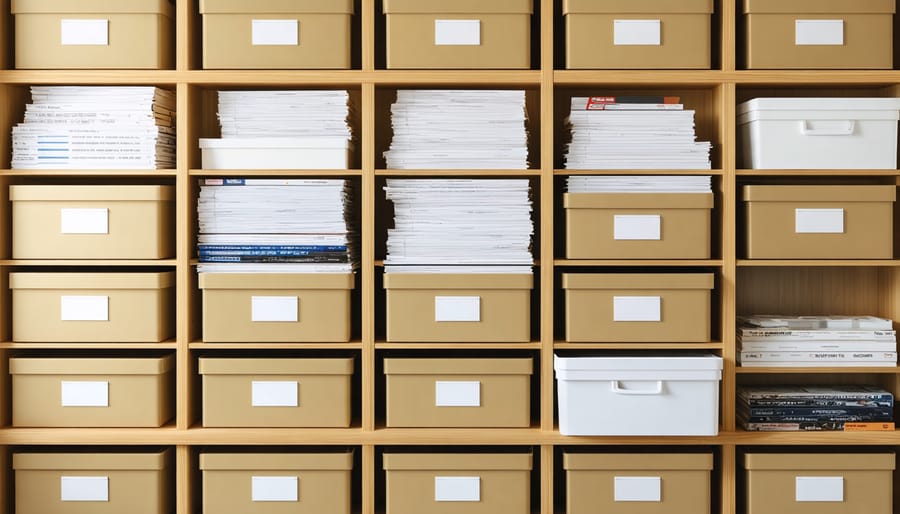
Creating the Right Storage Environment
Even the best archival boxes won’t protect your photographs if they’re stored in the wrong environment. Think of it this way: you’ve invested in quality storage, now let’s make sure the location does its part.
The ideal storage spot maintains consistent temperatures between 65-70°F with relative humidity around 30-40%. Basements might seem convenient, but they’re often too damp and prone to flooding. Attics are equally problematic, with temperature swings that can reach extreme highs in summer. Instead, look for interior closets or spaces within your home’s climate-controlled envelope. A bedroom closet on an interior wall typically offers more stable conditions than exterior storage areas.
I learned this lesson the hard way years ago when I stored family negatives in my garage, assuming the sealed boxes would protect them. After one humid summer, I discovered the beginnings of mold damage despite using quality archival boxes. The container can only do so much when the surrounding environment works against it.
For those serious about long-term preservation, consider investing in a basic temperature and humidity monitor. These devices, available for around twenty to thirty dollars, provide peace of mind and early warning if conditions drift outside acceptable ranges. Place the monitor near your archival boxes and check it monthly.
Keep boxes off the floor, ideally on metal shelving, to protect against potential water damage from leaks or flooding. Avoid storing them against exterior walls where temperature fluctuations are more pronounced. If you’re using a storage unit, choose a climate-controlled facility and visit periodically to verify conditions remain stable.
Remember, consistency matters more than perfection. A stable 72°F environment beats one that swings between 65°F and 75°F, even though the average seems ideal. Your photographs have survived this long; proper environmental storage ensures they’ll be around for future generations to enjoy.
Cost Considerations and Where to Buy
Let’s talk money, because archival boxes aren’t cheap. University Products archival boxes typically range from $15 to $40 per box, depending on size and configuration. That might seem steep when you can grab cardboard boxes at office supply stores for a few dollars each, but here’s the reality check: you’re not paying for cardboard, you’re paying for chemistry and longevity.
For professional photographers with client work or fine art prints destined for galleries, this investment is non-negotiable. I learned this the hard way when a box of supposedly acid-free materials from a craft store left yellow stains on vintage prints I was restoring for a client. The replacement cost far exceeded what I would have spent on proper archival storage from the start.
That said, not every photograph demands museum-grade storage. Personal snapshots, digital backup prints, or working copies can live in less expensive alternatives. Reserve University Products boxes for your irreplaceable originals, limited edition prints, or anything with significant monetary or sentimental value. Think of it like insurance: you protect what matters most.
Where can you buy them? University Products sells directly through their website, which offers the full catalog and occasional bulk discounts. You’ll also find their products at specialty retailers like Talas and Light Impressions. Some photography stores carry them, though selection may be limited. Buying direct often makes sense for larger orders, while retailers work well if you need just one or two boxes quickly.
Budget-conscious photographers can stretch their dollars by buying in bulk or mixing storage solutions strategically. Use University Products boxes for finished prints and client deliveries, while employing their more affordable sleeves and envelopes for intermediate storage. Some photographers create a tiered system: premium boxes for exhibition prints, mid-grade archival boxes for personal work, and basic archival sleeves for everything else.
The bottom line? If a photograph would hurt to lose, whether financially or emotionally, proper archival storage isn’t an expense, it’s essential preservation. For everything else, make informed compromises that balance your budget with your actual preservation needs.
Your photographic legacy deserves more than a cardboard box in the basement. Throughout this guide, we’ve explored why University Products archival boxes represent a genuine investment in preserving your work for generations to come. These aren’t just storage containers—they’re specialized tools designed with archival science principles that protect against the chemical and environmental factors that silently degrade photographs over time.
The key takeaways are straightforward: choose acid-free, lignin-free boxes that match your specific print sizes and storage needs. Remember that proper storage goes beyond just the box itself—maintaining stable temperature and humidity conditions, keeping prints away from direct light, and using interleaving materials all work together to create a preservation environment. For many photographers, starting with drop-front boxes for frequently accessed prints and transitioning to clamshell boxes for long-term archive storage offers the best balance of protection and practicality.
Here’s the reality: taking action today matters. Every day your prints spend in non-archival conditions is another day they’re slowly deteriorating. The good news is that making the switch to proper archival storage isn’t complicated or prohibitively expensive when you consider the irreplaceable value of your work.
Even as photography becomes increasingly digital, archival thinking remains essential. Digital files need their own preservation strategies, but physical prints continue to hold unique value as tangible artifacts of our visual stories. By protecting both formats thoughtfully, you’re ensuring your photographic vision endures for future generations to discover and appreciate.




